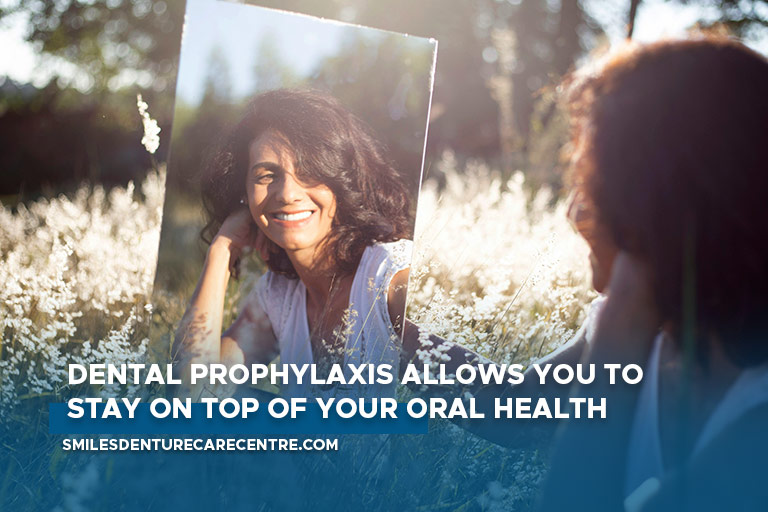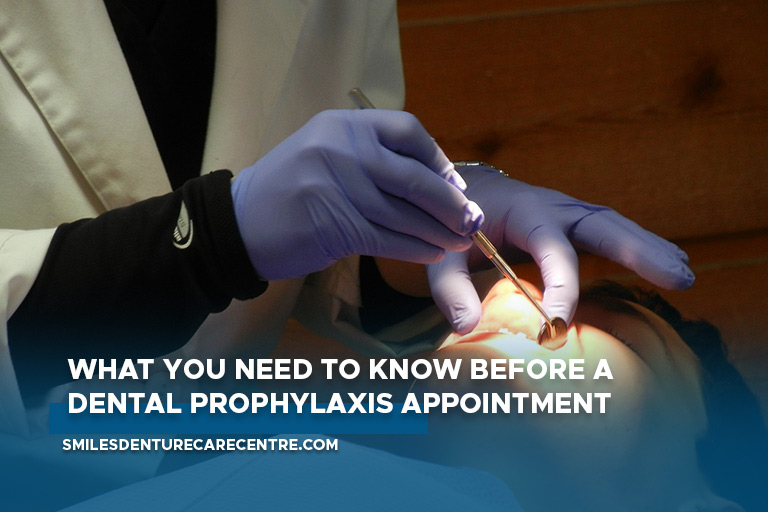When was the last time you visited your dentist? If you don’t remember, you may be due for a dental prophylaxis treatment. This kind of appointment is a preventive measure that involves cleaning the teeth and inspecting the mouth for signs of any potential oral health problems.
While following a daily oral care routine is vital for keeping your smile perfect, visiting a dental professional is a must. Let’s talk about the important facts you need to know before your dental prophylaxis appointment
What Is Dental Prophylaxis?

A dental prophylaxis is a cleaning procedure done to completely clean the teeth. It’s a crucial dental treatment for halting the development of gingivitis and periodontal disease. Gingivitis and periodontal disease occur when bacteria from plaque settle on the gum tissue, either below or above the gum line. The bacteria colonies cause severe irritation and inflammation which triggers a chronic inflammatory response in your body. Moreover, the body begins to destroy bone and gum tissue, shifting the teeth, making them unstable, or completely fall out.
What Is the Purpose of Prophylaxis Dental Cleaning?

Prophylaxis dental cleaning is an effective procedure to help keep your oral cavity in optimum condition and also stop the progression of gum disease.
Some benefits of dental prophylaxis include:
- Fresher breath – Halitosis or bad breath is usually an indicator of periodontal disease. It is caused by a combination of gangrene caused by gum infection, rotting food particles below the gum line, and periodontal problems. Removing plaque, bacteria, and calculus significantly improves halitosis and relieves irritation.
- Tartar removal – Plaque and tartar (calculus) buildup, both below and above the gum line, causes severe periodontal problems if not treated. Even if you use the best flossing and brushing techniques, it still can’t remove bacteria, deposits, and debris from your gum pockets. A dental professional’s trained eye using specially designed dental equipment is required to detect and treat problems like plaque and tartar buildup.
- Identifying health issues – Since dental prophylaxis involves an intensive examination of the oral cavity, the dentist is able to evaluate the risk of periodontitis, screen for oral cancer, and usually detect signs of diseases like kidney problems and diabetes.
- Aesthetic – It’s very difficult to smile confidently if you have stained, yellowing teeth. Dental prophylaxis can remove the ugly stains on your teeth and restore your smile to its former glory.
What Does a Dental Prophylaxis Treatment Involve?
Dental prophylaxis can be done in the course of a regular dental appointment or, if necessary, under general anesthetic. The latter is usually performed when severe periodontal disease is suspected or has been diagnosed by a dental professional. An endotracheal tube is sometimes inserted into the throat to prevent harmful bacteria extracted from the mouth from entering the lungs.
- X-Ray and Examination
X-rays help a dental professional detect potential oral health issues that aren’t highly visible to the naked eye, like cavities, for example. When your dental professional tells you that you have to get X-rays, you’ll probably get bite-wing X-rays of your premolar and molar teeth. There are some dental practices that will also take pictures of your anterior teeth, which are in front of your bite.
Dental X-rays can reveal so much about the state of your oral health, especially when it comes to periodontal disease. X-rays also show the level of gum and bone recession and also help the dental professional determine the areas which may require future attention.
However, if your teeth and gums are in excellent condition and you regularly visit your dentist, they may recommend X-rays less often than if you’re a risk for oral health problems. The following are some factors that are considered when deciding the frequency at which you should get X-rays:
- Oral health
- Discomfort in your mouth
- Risk for disease
- Age
- If you already show signs of oral disease
- Periodontal Probing
As your dentist updates your medical history, they will visually examine your gum tissues and conduct periodontal probing too. It involves the use of a tool known as a periodontal probe to measure the depth of your gum. It’s critical to measure gum tissue since our gums should fit snugly around our teeth. Due to age, medical conditions, or poor oral care, our gums may pull away from our teeth, producing pockets where bacteria and food bits can get stuck.
Aside from periodontal probing, your dentist will also inspect your teeth. This is to inform your dentist of any areas that should be probed for potential tooth decay. They’ll administer dental cleaning using special instruments (hand and ultrasonic) to remove tartar and plaque from the teeth and beneath the gum line. The dentist will also polish your teeth to get rid of tooth stains and then clean between your teeth using floss.
- Other Procedures
- Supragingival cleaning – The dentist will clean the area above your gum line using scaling tools to remove calculus and plaque.
- Subgingival cleaning – This is the most crucial step for people with periodontal disease because it involves removing calculus from the gum pockets and beneath the gum line.
- Root planing – The tooth root is smoothened to remove any remaining bacteria. These bacteria are very harmful to periodontitis patients, so removing them is one of the highest priorities of the dentist.
- Medication – After scaling and root planing, an antimicrobial cream is usually applied to the gum pockets. This cream aids in the fast and healthy healing in the pockets and helps alleviate discomfort.
How Often Should You Have a Dental Prophylaxis Appointment?
The frequency of dental prophylaxis appointments is not a “one size fits all” scenario. Some people need to book a dental prophylaxis appointment twice a year. While others have to follow a different schedule. It may be wise for people belonging to high-risk groups to have dental prophylaxis treatments every 3 to 4 months. These include people with gum disease, people who smoke, and people who frequently get cavities. Diabetic patients and pregnant women may also require more appointments than just twice a year.
Why Is Dental Prophylaxis Necessary?
You might be wondering why you need this dental treatment since you always take good care of your teeth. Several dental problems may go unnoticed during the early stages. You may even not feel pain or see visible signs. A prophylaxis appointment allows your dentist to diagnose these problems early. For instance, it’s typical not to feel discomfort from a cavity when it first forms. However, a dental professional will probably be able to see that cavity during the appointment and repair it before it worsens and causes you pain.
A prophylaxis treatment acts as a crucial preventive measure for maintaining oral health and perfect teeth. The dental X-rays, oral examination, teeth cleaning, periodontal probing, and a good relationship with a dental professional ensure that your mouth is as healthy as it can be. Whatever the cost of dental prophylaxis may be, you’re investing not only in your teeth but in your overall health as well.
If you’re looking for high-quality dentures or cleaning services for your dental appliance, then look no further than Smiles Denture Care Centre. We are a trusted full-service denture clinic in London, Ontario and we specialize in restoring smiles. Call us at (519) 457- 2800 for a free consultation.

